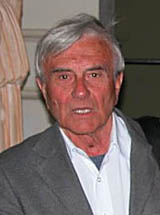
Architectural Education - Miroslav Masák
City Library Ostrava, June 16, 2006 | Organizers: Era 21 and Center for New Architecture
response to the discussion
|
> Introductory Report > Discussion Record Opinions of the discussants: > Yvette Vašourková > Jakub Kynčl > Ladislav Lábus > Emil Přikryl > František Sedláček > Aleš Student > Jiří Suchomel |
Reactions of invited personalities: > Mirko Baum > Karel Doležel > Helena Jiskrová > Ivan Koleček > Miroslav Masák > Alois Nový > Petr Pelčák > Marian Zervan |
 |
In a text addressed some time ago to architecture students, I quoted Miroslav Petříček's opinion that university studies cannot resign on either of its two main components. On education, which means the ability to think independently, to discover in the discovered, to search in the found, and to doubt the undisputed. And on upbringing, as a targeted set of activities leading to the birth of a personality, to the birth of a creative person with their own will and unique perspective. Thus, knowledge of the craft and talent must be in balance. Nevertheless, we occasionally encounter, even at the Ostrava round table, a somewhat populist opinion that creativity should take precedence. If one of the two components were to take precedence, it should be the knowledge of the craft.
If studies are to lead to graduates who can discover in the discovered, they must have a solid understanding of what has already been discovered. The essence of the complex service that architecture provides. Emil Přikryl rightly reminded the discussion of van Laan's definition of the necessary and essential in architecture. The necessary means knowledge of the field, the ability to consider appropriately the sociological, urban-planning, psychological, physiological, aesthetic, operational, technical, and economic requirements demanded by society and the client from a mature concept of an architectural work. How could a young graduate respect these requirements if they were not adequately familiar with their foundations? If they were not educated in the "craft"? My experienced acquaintance, a respected expert, says that the concept of a modern house should be based on fire safety regulations. Rem Koolhaas recently provoked with the remark that the form of buildings today is changed by air conditioning. And I believe that the face of good architecture is transformed more by the high operational costs than by the creativity of the stylist.
We used to be handball players. A sport that suffers without creativity. Through daily training, we gained excellent conditioning and the necessary ball technique (that is, the craft), so we could develop game creativity. Player intelligence was not gained through obsessive training of a single game; it grew from our way of life, from experiences in other sports and competitions, and from our state of mind. More than half of the players had to learn new variants of tactics; they had to adopt them and did not come up with their own ideas. They lacked game talent. Nevertheless, they were valuable teammates. The ability to be creative cannot be taught; it can only be developed if there is a willingness to do so. That was, for example, the focus in our Liberec School.
What do those who expect massive injections of creativity from schools actually call for? For their own conception of the world? Technical creativity? Aesthetic extravagance? For the unusualness of every concept, every standard proposal? This is not possible even in a highly individualized society that turns away from established values and welcomes everything "new," in a society where novelty and originality at all costs are elevated above meaningfulness.
In my first year of studies, in 1952, Professor Ausobský "encouraged" us with information that of one hundred percent of students, only 2.5 percent would become architects. In other words, architect succinctly expressed what we today describe as a personality combining high creativity, perfect knowledge of the craft, and managerial skills. There were ninety of us in the year. Fifty years after graduation, I observe that the professional criticism noted seven of us (6.3%) at that time; in the summarizing publication "Czech Architecture 1945-1994," only four are mentioned (that is, 4.5%). Schools should raise future creative personalities with basic orientation in the field. With the ability to think independently, which is conditioned by the necessary degree of knowledge and, of course, a certain degree of creativity. One does not exclude the other. Knowledge of the craft is essential. However, an extremely high degree of personal motivation is also necessary.
Miroslav Masák is an architect.
The English translation is powered by AI tool. Switch to Czech to view the original text source.
0 comments
add comment













